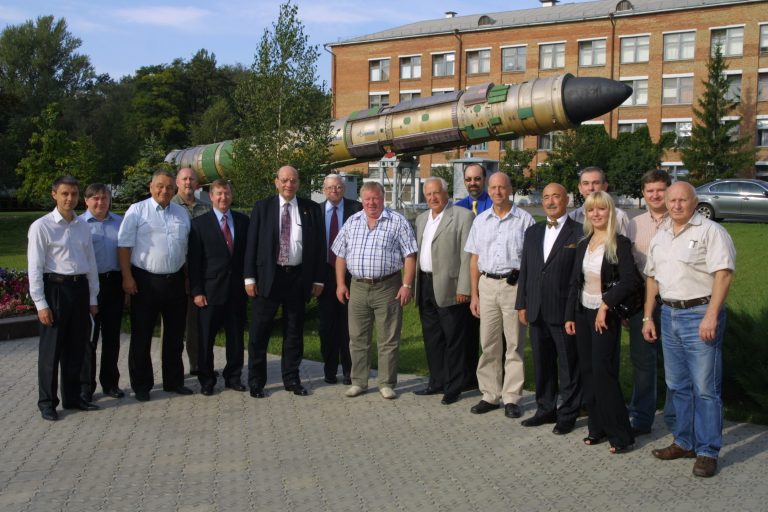Press-center
Press-center
LAUNCH OF MODERNIZED ANTARES LAUNCH VEHICLE
On May 21, 2018, at 11:44 Kiev time (04:44 North American Eastern Time), a successful launch of modernized Antares launch vehicle was made from the Wallops Flight Facility (Virginia, USA).
The Antares LV injected into orbit the Cygnus cargo spaceship, which will deliver to the ISS a 3350 kg payload – equipment required for space station operation.
The cargo spaceship of this mission was named in honor of James Tompson, former Chief Operations Director of Orbital ATK.
James Tompson (on the photo: 6th from the left) during the visit to Yuzhnoye SDO in September 2009.
The prime developer of Antares LV is Orbital ATK corporation (USA). The LV is intended for cargos delivery to the International Space Station (ISS) and for launching commercial and governmental spacecraft. The launch vehicle consists of two stages and Cygnus space tug (the third stage).
The Antares first stage core structure was developed by Yuzhnoye State Design Office and manufactured by Yuzhny Machine-Building Plant in cooperation with the Ukrainian companies: Hartron-ARCOS (Kharkov), Kievpribor (Kiev), Hartron-UCOM (Zaporozh’e), CHEZARA, RAPID (Chernigov) and others.
It should be noted that the first stage of this mission – ОА-9 underwent the firing bench tests in May 2016. In point of fact, this is a repeated use of the hardware.
The Antares LV prelaunch processing, testing and launch were conducted with participation of the specialists from Yuzhnoye SDO, SE PA YMZ, NPP Hartron-ARCOS. The Ukrainian specialists ensured in full scope the performance of all operations in their responsibility sector. In accordance with the contract, the technical launch support, telemetry information real time reception and processing were provided from Yuzhnoye SDO territory.
The Cygnus space tug consists of the equipment block, which accommodates the propulsion system, electric power supply system, navigation system, and of the sealed cargo compartment, which accommodates the payload. After separation from the Antares LV, Cygnus will deploy its solar arrays and by command will perform a series of propulsion system ignitions to raise orbit and will approach the ISS at the distance of approximately 4 km.
After receiving the permission, the spaceship will begin rendezvous with the ISS and when it will be at the distance of approximately 12 m, the ISS crew will perform mating using a robotized arm.
Cygnus will spend approximately five weeks being mated to the ISS, after which at a certain orbit point it will be unmated by the ISS crew. Then, Cygnus will perform a series of engine ignitions, which will transfer it to the drive-away trajectory to the distance safe for the ISS which will be confirmed by the Flight Control Center in Houston.
In approximately two days after Cygnus leaves the ISS, the spaceship will start the engine, which will operate ∼7 minutes for deorbiting. It will take about 30 minutes for Cygnus to enter dense atmosphere where it will be safely destructed above the Pacific Ocean.
* * *
This is the ninth out of the ten planned flights of Orbital ATK under the program fulfilled under contract with NASA and the sixth flight of Cygnus spaceship with increased sealed cargo module.
In the framework of Antares program, the Ukrainian party performed the full package of works to design, test and manufacture the hardware of LV first stage core structure ordered by the US National Space Agency.
The Antares project is a good example of the participation of Ukrainian space industry companies in the international space projects, booming of external economic activity of the companies, activation of the national space rocket industry presence on the world’s space market.
Related posts
ACTIVITIES ARE UNDER WAY TO DEVELOP THE UKRAINIAN ARTILLERY MISSILES TAIFUN-1 FOR GRAD MULTIPLE ROCKET LAUNCHER SYSTEM
ANTARES LAUNCHES CYGNUS WITH CARGO FOR INTERNATIONAL SPACE STATION
OFFICIAL COMMENTS ON THE STATUS OF SICH -2-1 (SICH -2-30)
CONDOLENCES TO THE FAMILIES, FRIENDS AND FELLOW-SOLDIERS OF THE TRAGICALLY KILLED ON THE TERRITORY OF SE YUZHMASH AND SE YUZHNOYE SDO
https://fineline.uk.com/modelmaking/
https://yvonnedme.com/premier-bet-zone-mobile/
https://navesa.com.br/politica-de-privacidade/
https://novosolhares.ibase.br/
https://lyon.snuep.fr/category/mutations/intra/
https://cucgachcafe.com.vn/luong-minh-phuong-la-ai/
https://www.eral-tribune.fr/lagence/
https://smartcount.ict.ihu.gr/
https://vivo500-joker-lonely17.pages.dev/
https://www.satisfactory.life/contacto/
https://www.booksarepopculture.com/
https://tunaskaryajakarta.sch.id/
https://www.visitasguiadastui.com/contacto/
https://www.vizgraphics.com/showcase/
https://jdi.ac.ug/application/
https://www.kiadesivo.com.br/contato/
https://www.kiadesivo.com.br/obrigada-pela-compra/
https://www.kiadesivo.com.br/politica-de-privacidade/

